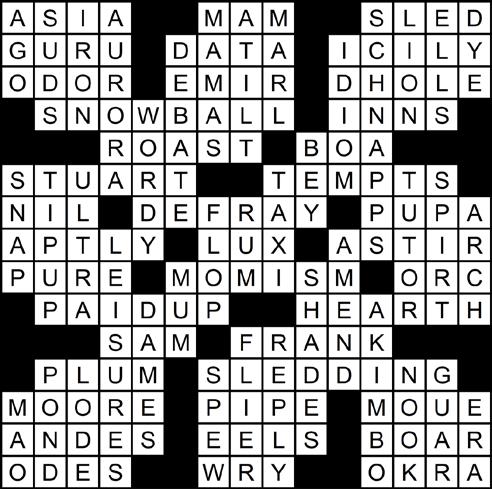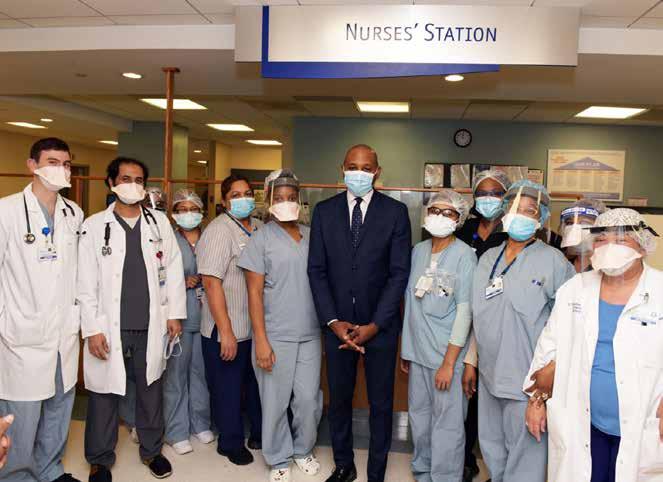HEALTH
HARLEM COMMUNITY NEWSPAPERS
ASK DR. KEVIN: The Value of Caregiver Support While Navigating An ATTR-CM Journey By Dr. Kevin Williams, Chief Medical Officer for Rare Disease at Pfizer
T
Rare Disease in collabora-
White. Hereditary ATTR-CM is in-
or trusted friend, an advocate who
“My wife is my only caregiver. With
tion with the National Newspaper
herited from a relative and is a ge-
can provide physical and emotional
my disease, I am not able to do much
Publishers Association (NNPA) to
netic mutation, affecting both men
support can be a significant benefit to
around the house, so I rely on her. She
increase understanding of hereditary
and women. In the United States, the
a patient facing life with ATTR-CM.
insists that I take medication on time,
transthyretin amyloid cardiomyopa-
most common genetic mutation as-
In the case of hereditary AT-
thy (ATTR-CM), and the risk it pos-
sociated with hereditary ATTR-CM,
TR-CM patients, most are assessed
es to African Americans.
V122I, is found almost exclusively
generally by a primary care physi-
Being diagnosed with a rare
in people of African descent with
cian (PCP) before being referred to a
Caregivers play an important part
disease can be overwhelming, and
a prevalence of roughly 3 percent,
cardiologist for assessing unresolved
in helping navigate the “new normal”
it can be just as difficult if a loved
although people who have the mu-
specific symptoms related to the dis-
of ATTR-CM, and their responsibil-
A caregiver can help only as
one receives a diagnosis. In the case
tation may never develop symptoms
ease. For some, this can take a longer
ities can vary based on the unique
much as the patient will let them,
of ATTR-CM, a life-threatening,
of the disease. Symptom onset can
period of time and delay diagnosis.
needs of the person who is living with
which is why it’s essential to have an
underdiagnosed disease that’s as-
occur in people as early as their 50s
A caretaker or family member who
the condition. While some caregivers
open and honest dialogue about how
hereditary ATTR-CM,
sociated with heart failure, it’s im-
or 60s. [4] [5]
nosis to daily management following
up to Priscilla to talk about how he
he “Ask Dr. Kevin” series
caused by a mutation in a person’s
a confirmed diagnosis. Whether it’s
was feeling and the help he needed
is brought to you by Pfizer
genes. Most wild-type patients are
a spouse, partner, child, grandchild
to manage his hereditary ATTR-CM.
she keeps me on a routine.” Caregiving is Not a “One-SizeFits-All” Approach
tions, taking notes and communicat-
ilarly, caregivers must carve out time
ing worries that the patient may have
to recharge and practice self-care,
previously expressed to them.
even when others may be depend-
Communicating with a Caregiver
ing on them. In both cases, communication is key to ensuring that the patient-caregiver relationship is one built on mutual trust and support. If you’d like to learn more about including
is available to advocate on behalf of
play a more supportive role, checking
ATTR-CM symptoms affect daily
common signs and symptoms, vis-
portant to take it one day at a time.
While every ATTR-CM patient
the patient and ask their PCP more
in and listening when a patient wants
activities and one’s physical and
it www.YourHeartsMessage.com.
[1],[2],[3] Learning more about the
journey is unique, it helps to have a
questions about what they are expe-
to talk about how they are feeling, oth-
emotional well-being. By helping a
*Dr. Kevin Williams is the chief
condition, how to manage it and
support system in place while navi-
riencing may help speed up a refer-
ers need to take a more hands-on ap-
caregiver understand what they’re
medical officer for Rare Disease at
where to find support are some of
gating life with the disease. Having
ral.
proach and can help with maintaining
going through, the patient can em-
Pfizer. He pursued medicine after be-
the best methods to navigate an AT-
a caregiver to lean on for assistance
When Randy, who is living with
medical records, managing treatment
power the caregiver to provide them
ing inspired by his father’s work as
TR-CM diagnosis.
can provide much needed peace of
the hereditary form of ATTR-CM,
and accompanying the patient to doc-
with the best possible care.
a general practitioner in his home-
mind.
was first diagnosed, his wife Priscilla
There are two sub-types of AT-
1,
,
tor visits.
This also includes communicat-
town of Baton Rouge, Louisiana. Dr.
TR-CM, wild-type and hereditary.
The Role of a Caregiver
was surprised because he had always
Many patients find bringing a
ing personal boundaries. Caregivers
Kevin is passionate about raising
Wild-type ATTR-CM is thought to
A caregiver may play a critical
been very healthy and active. She had
caregiver to their doctor appoint-
need to know when a patient needs
awareness and increasing under-
be the most common form of AT-
role throughout every stage of the
many questions about how the condi-
ments is very helpful, as he or she
help with certain activities and when
standing of ATTR-CM in the African
TR-CM, is mostly associated with
ATTR-CM journey – from helping to
tion might affect him and their life to-
can contribute during the visit by
they would prefer to be and have the
American community. You can fol-
men over the age of 60 and is not
identify symptoms early on to diag-
gether, but it was Randy who opened
discussing symptoms, asking ques-
ability to be more independent. Sim-
low Pfizer on Facebook and Twitter.
Polycystic Kidney Disease: Is It Hiding in Your Genes?
P
growth. Additionally, ADPKD is the
of ADPKD are inherited, in approximate-
function and properly manage the dis-
most common inherited renal disease/
ly 5%‒10% of patients with ADPKD, no
ease, as well as help avoid related com-
Disease
kidney disorder and according to recent
family history can be documented, sug-
plications such as high blood pressure,
(PKD), causes numerous cysts
data, affects as many as 140,000 Amer-
gesting spontaneous mutations.
urinary tract infections, kidney stones,
to grow in the kidneys and for
icans. Overall, ADPKD is the fourth
How ADPKD is diagnosed
infected or bleeding cysts, abdominal
those affected by this condition, nearly
leading cause of ESRD. ADPKD is a
Typically, ADPKD is diagnosed
bloating/discomfort and chronic pain.
50% will experience End Stage Renal
progressive condition and may even-
by ultrasound, however, a computer-
Educational resources, such as www.
Disease (ESRD) by age 60. According
tually lead to kidney failure requiring
ized tomography (CT) scan or magnet-
PKDInfo.com, can help people have
to the National Kidney Foundation,
some form of renal replacement thera-
ic resonance imaging (MRI) may also
an informed conversation with a doctor
autosomal dominant polycystic kid-
py, either dialysis or kidney transplant.
be conducted. Genetic testing may also
about ADPKD. The website provides the
ney disease (ADPKD) accounts for as
While ADPKD is considered a rare
be used for people with inconclusive
many as 90% of all polycystic kidney
disease and is relatively unknown to most
imaging results, those with no family
disease cases.
people, it’s unfortunately all too common
history of the condition, those who
Dr. Charlotte Jones-Burton of Ot-
in families impacted by the condition.
want to determine if they can pass the
the size of his or her kidneys. Although
critical. While signs and symptoms of
such as maintaining a healthy diet, staying
suka Pharmaceutical Development &
Children of parents with ADPKD have
gene on to their children, and for diag-
disease progression can be highly vari-
ADPKD often develop between the
physically active, getting enough sleep
Commercialization, Inc. offers the fol-
a 50% chance of inheriting the disease.
nosis of possible kidney donors.
able, even among family members, it’s
ages of 30 and 40, individuals with a
and aiming for a healthy weight to help
lowing insights into the condition:
This is a sobering statistic, however, a
Using the latest technologies,
important to confirm diagnosis early
history of kidney diseases – especially
keep kidneys healthy.
critical first step for people with a fam-
physicians can now identify ADPKD
on, as patients with rapidly progressing
if they know ADPKD is in their fam-
Concerned about ADPKD? Use
ily history of chronic kidney disease or
patients at risk for rapid progression
ADPKD reach ESRD at a younger age.
ily – shouldn’t delay speaking with a
trusted resources to get the facts or
olycystic
Kidney
The most common inherited kidney disorder
PHOTO SOURCE: (c) monkeybusinessimages / iStock via Getty Images Plus
latest information for understanding the disease and learning more about developing an effective management strategy,
ADPKD, the most common form
ADPKD is to discuss the condition with
of kidney function decline as well as
Management strategies
kidney specialist, also known as a ne-
schedule an appointment with your
of PKD, is a genetic kidney disease
relatives and a kidney care specialist as
estimate how quickly someone with
Since ADPKD worsens with
phrologist. By acting early, they’ll be
doctor to learn more about your risk
that leads to cyst formation and kidney
early as possible. However, not all cases
ADPKD is likely to progress based on
time, early diagnosis and treatment is
able to take steps to help protect kidney
factors and management strategies.
Harlem Community Newspapers | December 24. 2020
(Statepoint)
17









